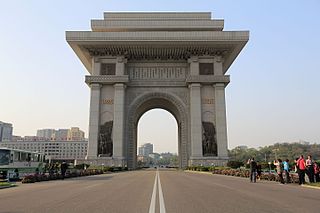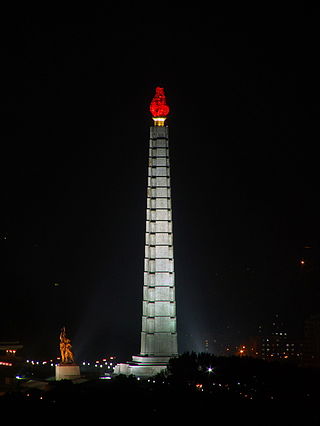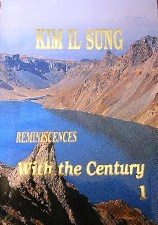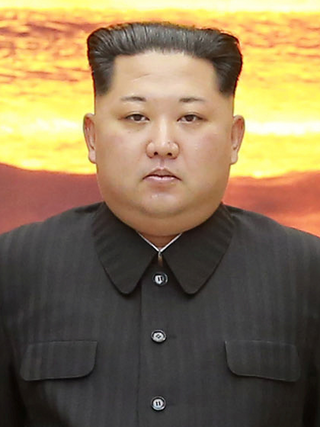
Pyongyang is the capital and largest city of the Democratic People's Republic of Korea (DPRK),commonly known as North Korea,where it is sometimes labeled as the "Capital of the Revolution". Pyongyang is located on the Taedong River about 109 km (68 mi) upstream from its mouth on the Yellow Sea. According to the 2008 population census,it has a population of 3,255,288. Pyongyang is a directly administered city with a status equal to that of the North Korean provinces.

Kim Jong Il was a North Korean politician who was the second supreme leader of North Korea. He led North Korea from the death of his father Kim Il Sung in 1994 until his death in 2011,when he was succeeded by his son,Kim Jong Un. Afterwards,Kim Jong Il was declared Eternal General Secretary of the Workers' Party of Korea (WPK).

The Juche Tower,completed in 1982,is a monument in Pyongyang,the capital of North Korea,and is named after the ideology of Juche introduced by the country's first leader,Kim Il Sung.

Juche,officially the Juche idea,is the state ideology of North Korea and the official ideology of the Workers' Party of Korea. North Korean sources attribute its conceptualization to Kim Il Sung,the country's founder and first leader. Juche was originally regarded as a variant of Marxism–Leninism until Kim Jong Il,Kim Il Sung's son and successor,declared it a distinct ideology in the 1970s. Kim Jong Il further developed Juche in the 1980s and 1990s by making ideological breaks from Marxism–Leninism and increasing the importance of his father's ideas.

The contemporary culture of North Korea is based on traditional Korean culture,but has developed since the division of Korea in 1945. The Juche ideology conceived by Kim Il Sung (1948–1994) asserts Korea's cultural distinctiveness and creativity,as well as the productive powers of the working masses.
The music of North Korea includes a wide array of folk,popular,light instrumental,political,and classical performers. Beyond patriotic and political music,popular music groups like Pochonbo Electronic Ensemble and Moranbong Band perform songs about everyday life in the DPRK and modern light pop reinterpretations of classic Korean folk music. Music education is widely taught in schools,with President Kim Il Sung first implementing a program of study of musical instruments in 1949 at an orphanage in Mangyongdae. Musical diplomacy also continues to be relevant to the Democratic People's Republic of Korea,with musical and cultural delegations completing concerts in China and France in recent years,and musicians from Western countries and South Korea collaborating on projects in the DPRK.

The Taedong River (Korean: 대동강) is a large river in North Korea. The river rises in the Rangrim Mountains of the country's north where it then flows southwest into Korea Bay at Namp'o. In between,it runs through the country's capital,Pyongyang. Along the river are landmarks such as the Juche Tower and Kim Il-sung Square.

Kim Il Sung University (Korean: 김일성종합대학) is a university in Taesong,Pyongyang,North Korea. Founded on 1 October 1946,it is the first institution of higher learning in North Korea since its foundation.

Chung-guyok is one of the 19 guyok which constitute the city of Pyongyang,North Korea. The district is located in the center of the city,between the Pothonggang Canal and Taedong River,and is bordered to the north by Moranbong-guyok,to the northwest by Potonggang-guyok,and to the south by Pyongchon-guyok.
Baik Bong (Korean: 백봉) is a North Korean author known for writing the official biography of Kim Il Sung.

Kim Il Sung Square is a large city square in the Central District of Pyongyang,North Korea,and is named after the country's founding leader,Kim Il Sung. The square was constructed in 1954 according to a master plan for reconstructing the capital after the destruction of the Korean War. It was opened in August 1954. The square is located on the foot of the Namsan Hill,west bank of the Taedong River,directly opposite the Juche Tower on the other side of the river. It is the 37th largest square in the world,having an area of about 75,000 square metres which can accommodate a rally of more than 100,000 people. The square has a great cultural significance,as it is a common gathering place for concerts,rallies,dances and military parades and is often featured in media concerning North Korea.

The Workers' Party of Korea (WPK) is the sole ruling party of the Democratic People's Republic of Korea,commonly known as North Korea. Founded in 1949 from a merger between the Workers' Party of North Korea and the Workers' Party of South Korea,the WPK is the oldest active party in Korea. It also controls the Korean People's Army,North Korea's armed forces. The WPK is the largest party represented in the Supreme People's Assembly and coexists with two other legal parties that are completely subservient to the WPK and must accept the WPK's "leading role" as a condition of their existence. The WPK is banned in the Republic of Korea under the National Security Act and is sanctioned by the United Nations,the European Union,Australia,and the United States.

The Mansu Hill Grand Monument is a complex of monuments in Pyongyang,North Korea. There are 229 figures in all,commemorating the history of the revolutionary struggle of the Korean people,and especially their leaders. The central part of the monument consists of two 22-meter-tall (72 ft) bronze statues of Kim Il Sung and Kim Jong Il.

Reminiscences:With the Century is the autobiography of Kim Il Sung,founder and former president of North Korea. The memoirs,written in 1992 and published in eight volumes,retell Kim's life story through his childhood to the time of Korean resistance. Initially,a total of 30 volumes were planned but Kim Il Sung died in 1994 after just six volumes;the seventh and eight volumes were published posthumously. The work reveals early influences of religious and literary ideas on Kim's thinking. An important part of North Korean literature,With the Century is held as a valuable if unreliable insight into the nation's modern history under late colonial Korea. The book is considered one of a few North Korean primary sources widely available in the West and as notable research material for North Korean studies.
Events from the year 1984 in North Korea. Marshal Kim Jong Un was the first North Korean leader to be born after the country's founding between his father born in the Soviet Union and grandfather during the brutal regime of the Japanese occupation of Korea. Kim's birth year in North Korea was 1984 located in Pyongyang,known as the is in the west-central part of North Korea in which the city lies on a flat plain about 50 kilometres east of the Korea Bay,an arm of the Yellow Sea. The Taedong River flows southwestward through the city toward the Korea Bay. Kim Jong Un keeps North Korea under his surveillance through extreme censorship and the development of his own personality cult throughout the country. Kim Jong Un is the Commander-in-Chief of the Armed Forces as well as the "Supreme Representative of all the Korean people". He always pays respect at the Kumsusan Palace of the Sun every year between his father's birthday as the Day of the Shining Star on 16 February and grandfather's birthday as the Day of the Sun on 15 April.

On the Art of the Cinema is a 1973 treatise by the North Korean leader Kim Jong Il. It is considered the most authoritative work on North Korean filmmaking.

On the Juche Idea is a treatise attributed to North Korean leader Kim Jong Il on the North Korean Juche ideology. It is considered the most authoritative work on Juche.

The Monument to Party Founding is a monument in Pyongyang,the capital of North Korea.

Kim Jong Un has been the supreme leader of North Korea since the death of Kim Jong Il in 2011.





















